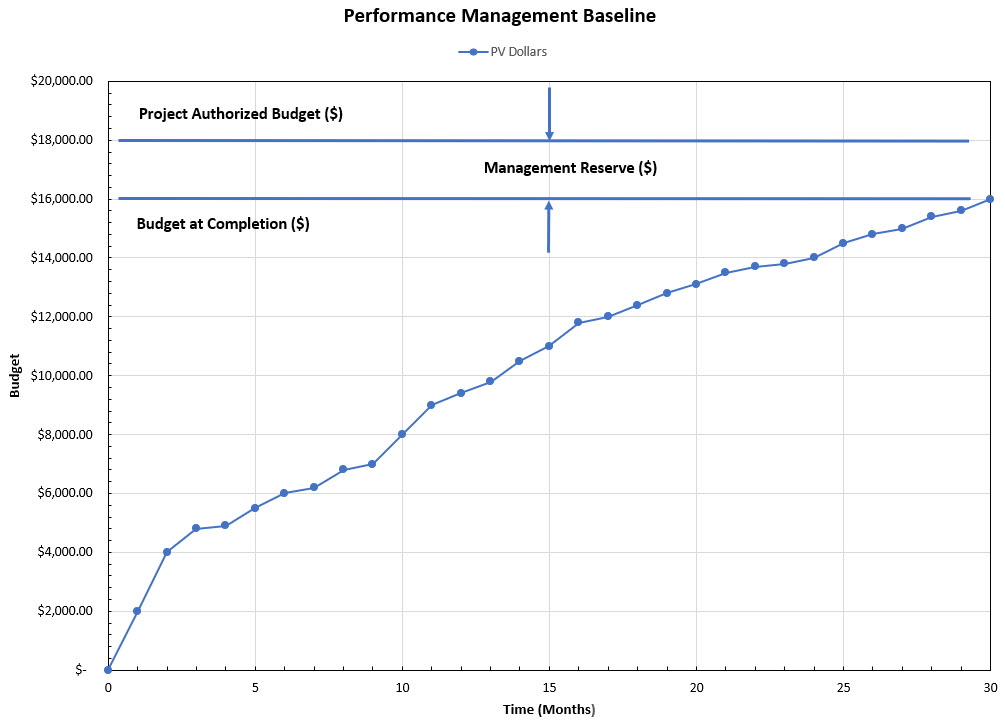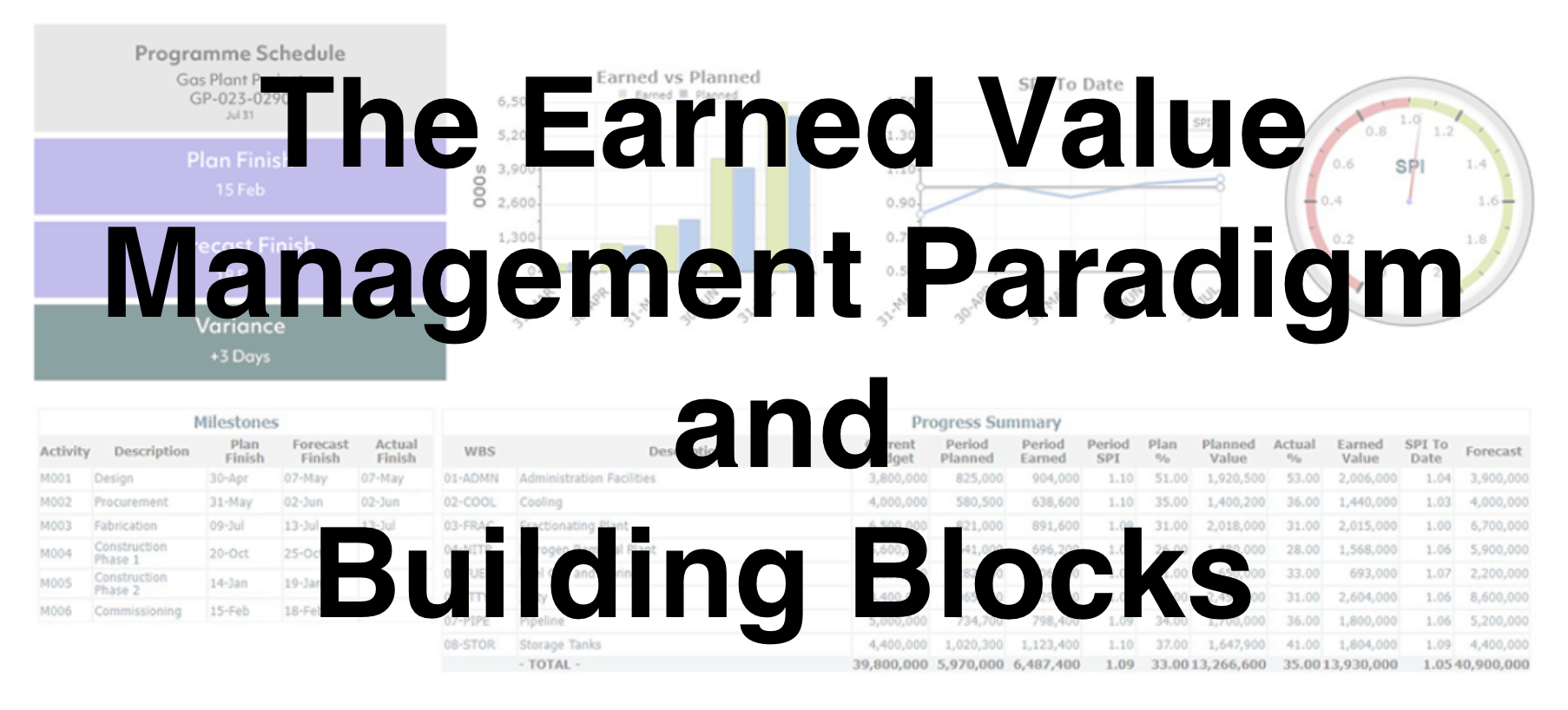 For many, Earned Value Management (EVM), at its heart, is a paradigm shift in the way we consider and focus on a few fundamental project parameters. It opens the door to a treasure trove of performance assessment and forecast insight for projects.
For many, Earned Value Management (EVM), at its heart, is a paradigm shift in the way we consider and focus on a few fundamental project parameters. It opens the door to a treasure trove of performance assessment and forecast insight for projects.
A major duty of the project manager is to keep the project on schedule and budget. Program managers at regular intervals want to know each project’s status, likely completion date, and final cost. Provision for reporting this crucial information necessitates a reliable way for the project manager to assess the project’s progress to date and foresee performance going forward.
Earned Value Management (EVM) is a proven tool for harvesting this information from project data. The linchpin of EVM is its ability to shift focus from deliverables planned, deliverables completed, and funds spent to the value of work planned, the value of work completed, and the funds spent. The transformation of these data inputs to an all-economic (dollars) basis enables analysis that is otherwise not possible. And viewing the project through the prism of value planned and value accomplished sheds light on the true schedule situation.
A project understanding based solely on time and money spent leaves the project manager in a shadow of darkness and is likely misleading. EVM provides powerful tools to analyze the true project performance. And only four parameters are required to compute and plot several metrics; these are insightful tools to measure project status and pr project conclusion.
This article discusses fundamental Earned Value Management (EVM) concepts, and the four parameters required to unlock a wealth of EVM metrics to assess and forecast project performance.
A Paradigm Shift
A project management truth is that percentage spent does not always equate to percentage done! Percentage spent is a financial expenditure statement, and not an indicator of project progress. Another axiom is that time expended does not confirm that work was accomplished. Schedules, including Gantt charts, provide a measure of insight into progress. But is completed work (milestones reached and deliverables completed) worth the funds spent for this achievement? EVM is a new paradigm that has the project manager consider what has been accomplished without thinking about funds spent or time consumed.
Planned Value
EVM begins with the premise that work is worth the planned or negotiated value (budget) of the work. In earned value the budget is synonymous with work to be done, or budget equates to scope. A $2 million budget means that the sponsor agrees the project deliverable is valued at $2 million. The $2 million value simultaneously represents two concepts (1) the expectation of spending $2 million and (2) the work is worth $2 million.
Planned Value (PV) is the EVM term for the value of work planned. It is the sum of each task’s time-phased budget, the value of all project efforts. Each effort has two attributes: its value (allocated budget) and its planned completion date (allocated time). The Performance Management Baseline (PMB) chart, Figure 1, plots both this value ($) and time (Months) for all project work.
The PMB plot is the cumulative value of all project activities and their budgets or PV on the y-axis and time on the x-axis. More directly, it is the cumulative PV of all the products (and services) that should be accomplished each reporting period.
Budget at Completion
The PMB chart plots the cumulative PV starting at zero and increasing to the value of the whole project, again, Figure 1. The total PV for a project is termed the Budget at Complete (BAC). This BAC value, i.e., all work in the project plan, represents project scope in financial terms. The BAC value is one of the four key data inputs that function as the building blocks to a wealth of EVM project assessment and forecasting metrics.
At the project beginning all funds are available and no work is completed, the PV on the PMB chart is zero. The cumulative PV on the PMB chart is the value of all the tasks to be completed each month (or reporting period) and then adding that sum to the previous month to yield the cumulative PV. The final cumulative PV at the end of the project is the total value for all activities from project start to end and is termed BAC.
Management Reserve
When the project manager sets aside contingency dollars, we have two budget amounts: (1) BAC, the project manager’s plan and (2) Project Authorized Budget (PAB), the amount agreed to by the sponsor and project manager. If the performing company is for profit, the PAB includes desired profit in addition to contingency. So, the PAB is the total price the buyer agrees to pay the seller.
The project manager plans to consume all the BAC but hopes little to no contingency or relevant profit funds are spent to complete the work. The contingency funds are called Management Reserve (MR). Figure 1 marks the MR, which is the PAB minus the BAC.
The MR is money set aside in the event of cost estimate inaccuracies and/or scope adjustments. MR is like a checking account for project risks. MR not consumed adds to profit. If consumed the result of the project is the target profit. The BAC plus MR or PAB is the maximum we hope to spend on the project and should be the approved budget. Profit is the difference between the incurred cost and the customer’s agreed price. If costs exceed the PAB, profit is less than zero; it is a loss.
Earned Value
Earned Value (EV) is the authorized work physically accomplished, valued at management’s budget, i.e., the negotiated price, for the completed work. This focus on accomplishment is the major EVM paradigm that serves as the cornerstone of all EVM analyses. Set aside time expended and funds spent. What is the value of your work achieved?
EV is denoted in dollars. EV accrues as each task effort completes. It begins at zero at project commencement. It then accumulates until the end of the project when EV equals the cumulative PV. A tenet of EV is that work has value equal to its budget, not funds spent working. EV is work budget accomplished and not necessarily funds spent to complete the work.
Actual Cost
The Actual Cost (AC) is the funds spent completing each activity effort. Compare the AC to the EV to find whether the project expenditures match the completed work or are over or under. This capability to compare the cost of work completed to the value of the work completed is a key EVM benefit. It answers the question, “Are the spent funds more or less than the value of completed work?”
Work Breakdown Structure
A good practice in planning project work is to “begin with the end in mind.” Early in project planning you want to define exactly what the end-product is that your work is producing. The Work Breakdown Structure (WBS) is a hierarchical breakdown of all the project deliverables, or the product (or service) that the project is producing.
Each lower element of the WBS breaks the deliverable down into a smaller more manageable scope of work. The lowest level of the WBS is the element where the project manager can definitively estimate both the duration and the cost of producing the respective deliverable. This WBS element at the lowest level is called the Work Package.
Organizational Breakdown Structure
After the product is clearly defined and broken down into manageable parts, the next question is who is responsible to complete the work? The organizational breakdown structure (OBS) decomposes the organization into departmental functions, integrated product teams, integrated project teams, and/or subcontractors. The OBS pinpoints organizational responsibilities within a project.
Every organization has different types of projects. The OBS groups them into categories to support the strategic requirements of the business. Each individual part of this structure is the OBS element and referred to as the responsible manager.
Control Account
The interconnection of the WBS and the OBS is the Control Account, which is the central management point for the project. It is where the budget or PV for each Work Package is specified, EV recorded, and AC collected. The Control Account is at the intersection of the lowest WBS element (Work Package) and the OBS element (Responsible manager).
The assignment of responsibility for these Work Packages is depicted through a Responsibility Assignment Matrix (RAM). The person accountable for the completion of work in a respective Control Account is the Control Account Manager (CAM). Figure 2 details the WBS and OBS, and their intersection in the responsibility matrix.
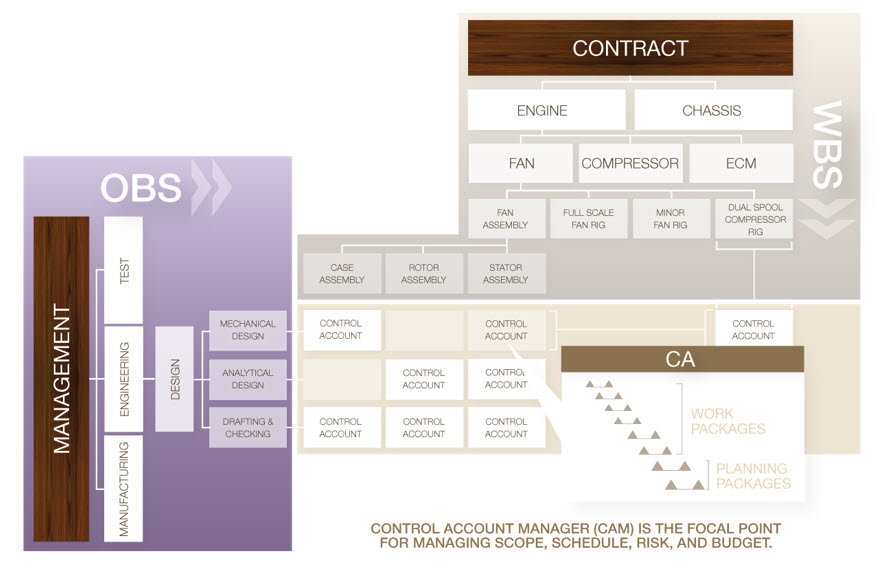 Figure 2
Figure 2
A Control Account may have multiple work packages gathered from several cells on the responsibility matrix.
EVM Metric Data Inputs
The Control Account tabulated data values PV, EV, and AC together with the BAC provide all the data inputs or building blocks required to calculate a wealth of project assessment and performance forecast metrics. These data value inputs again are as follows:
PV – Value of Planned Work
EV – Value of Work Done
AC – Funds Spent
BAC – Project Manager’s Planned Budget
A sample plot capturing all four of these data input values is in Figure 3.
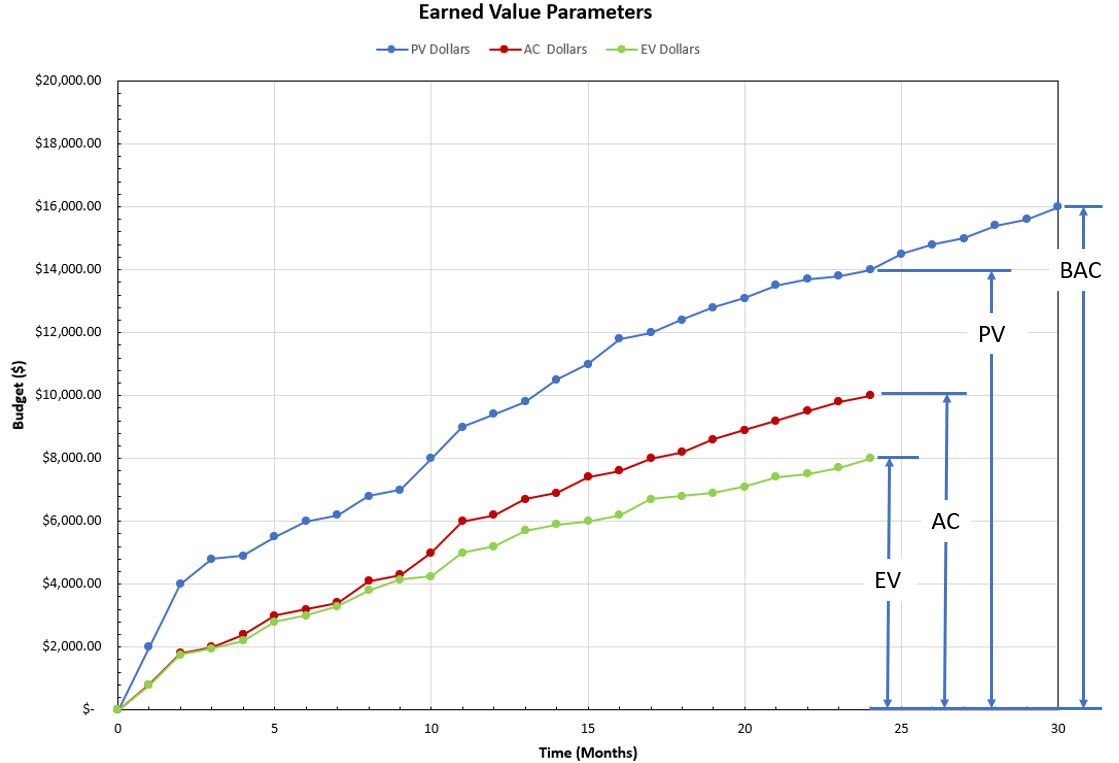 Figure 3
Figure 3
Keep in mind that accurate forecast metrics require the cumulative (and not periodic) values of each of the following parameters: PV, EV, and AC. And BAC is the total cost of the project.
Summary
Like pieces of a puzzle how you view and focus on a few project parameters can have a profound effect on their utility to assess the true project situation and predict future project performance. Earned Value Management (EVM) shifts the paradigm from time expended and funds spent to achievement.
What have you accomplished?
This subtle shift in viewpoint is all that is necessary to define and capture four project data values that generate a surprising amount of EVM metrics. A good understanding and perspective of these four horsemen parameters support proper utility of them in these many EVM metric analyses.
Below is a list of project assessment and forecast metrics that derive from the PV, EV, AC, and BAC parameters:

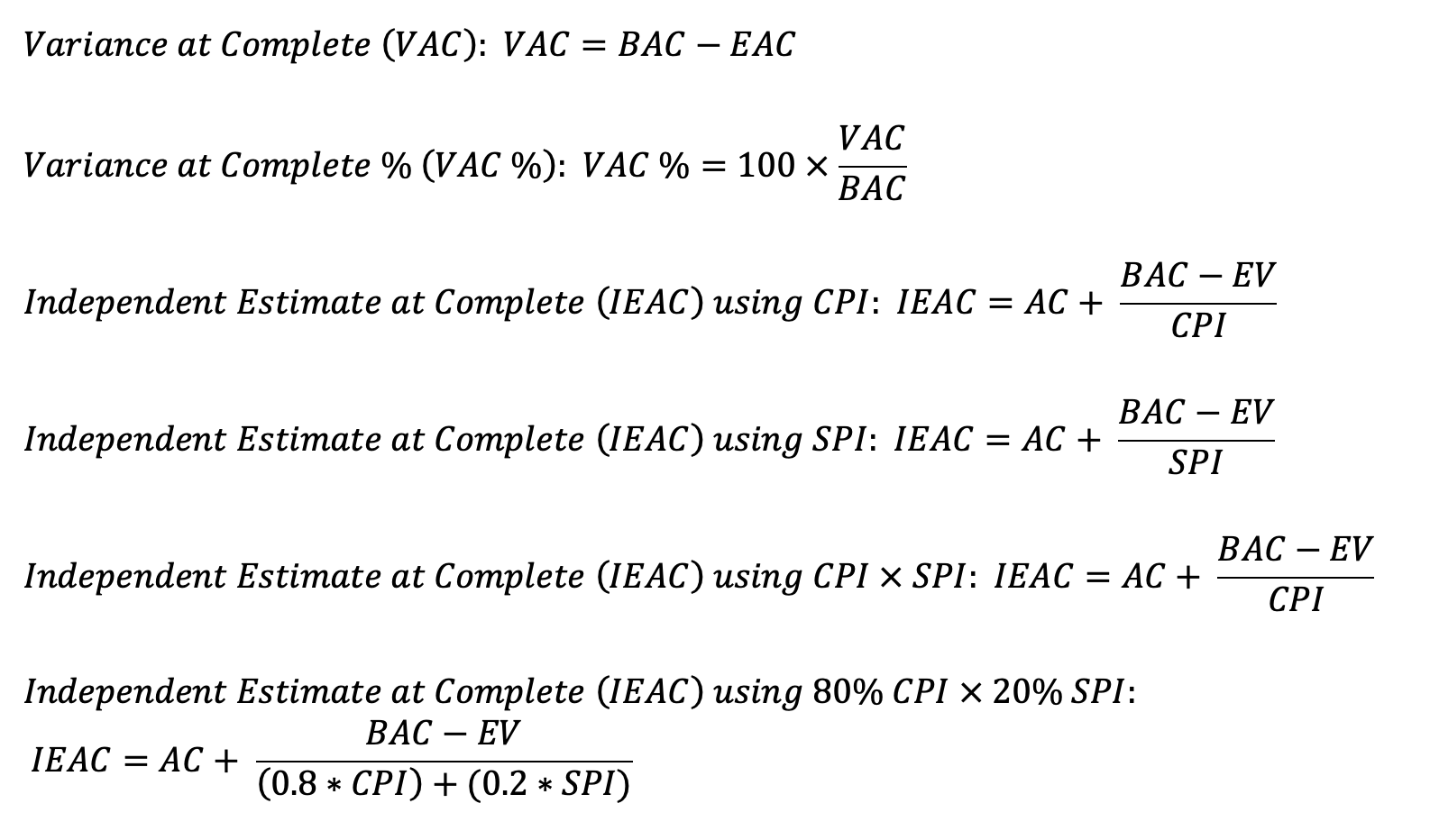
Further reading recommendations:
- Stratton, Ray W. “The Earned Value Management Maturity Model”, Leesburg, Management Concepts, 2006.
- Flemming Quention W. and Koppleman Joel M. “Earned Value Project Management”, Newtown Square, Project Management Institute, 2010.
- Koster, Kim, Wallace, Dave, Kinder, Jason, and Bell, Chris. “Earned Value Management for Dummies: Deltek Special Edition”, Hoboken, Wiley Publishing, 2011.

